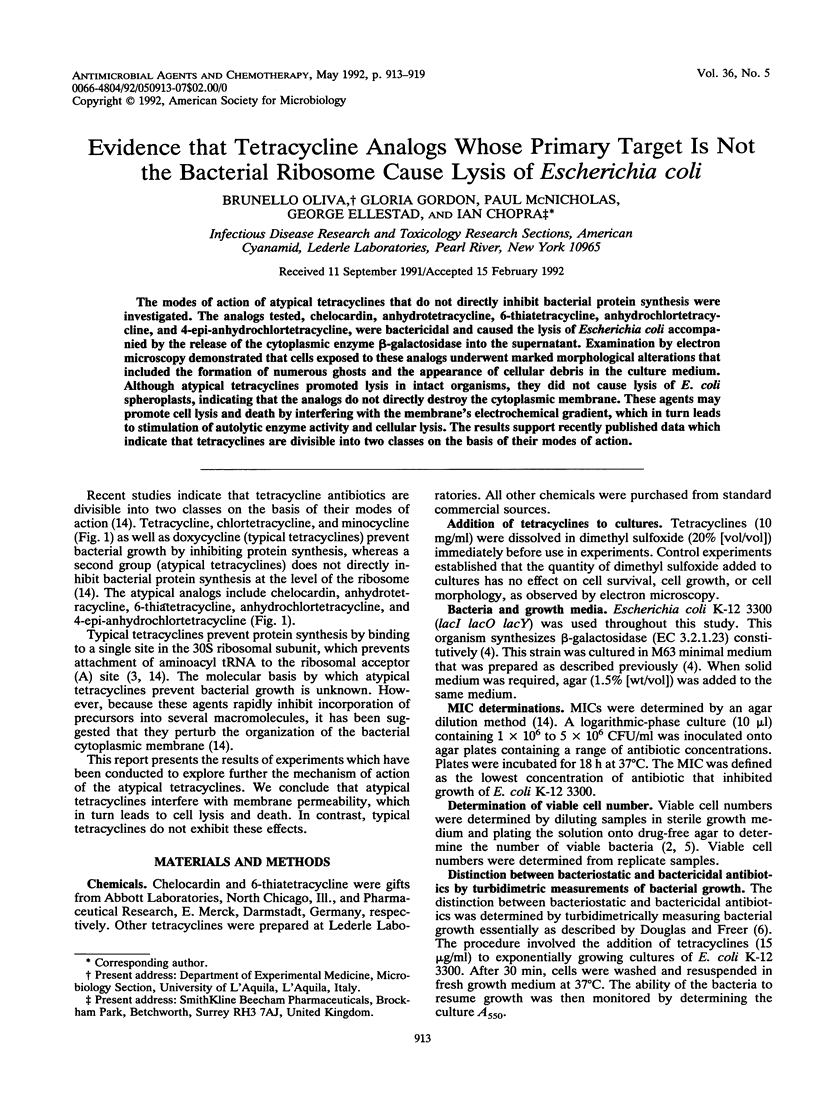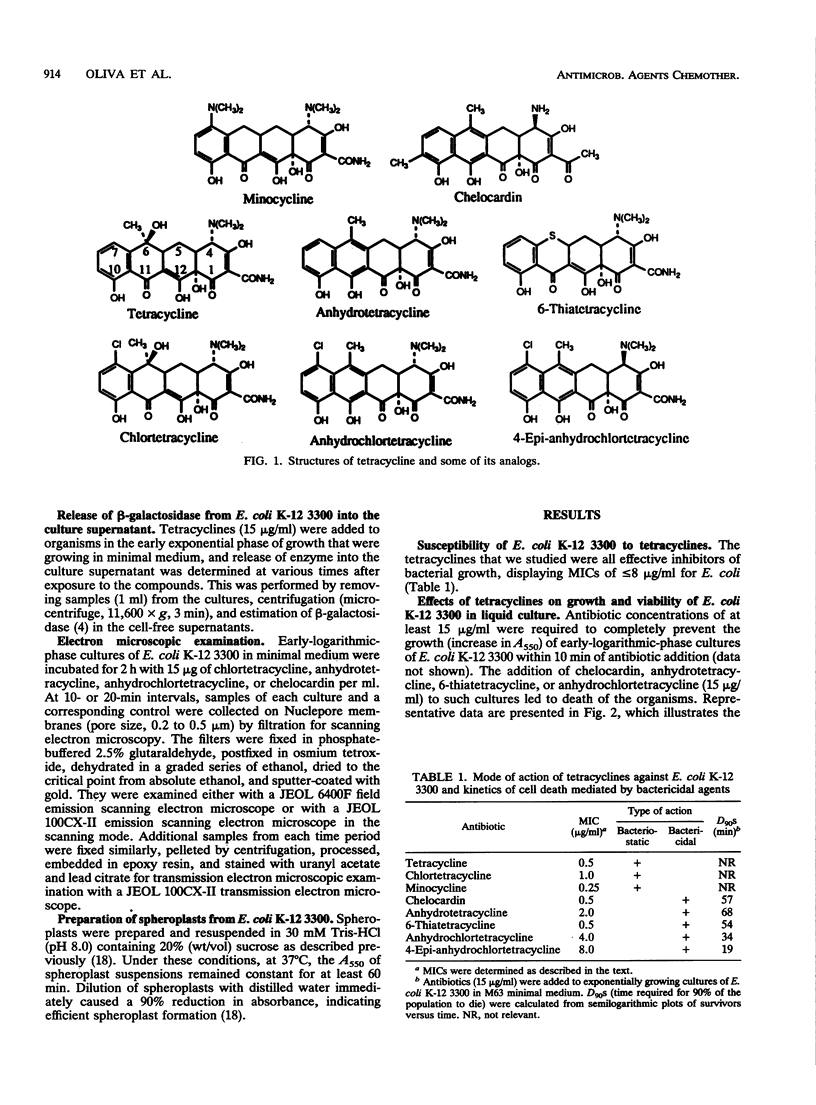Abstract
The modes of action of atypical tetracyclines that do not directly inhibit bacterial protein synthesis were investigated. The analogs tested, chelocardin, anhydrotetracycline, 6-thiatetracycline, anhydrochlortetracycline, and 4-epi-anhydrochlortetracycline, were bactericidal and caused the lysis of Escherichia coli accompanied by the release of the cytoplasmic enzyme beta-galactosidase into the supernatant. Examination by electron microscopy demonstrated that cells exposed to these analogs underwent marked morphological alterations that included the formation of numerous ghosts and the appearance of cellular debris in the culture medium. Although atypical tetracyclines promoted lysis in intact organisms, they did not cause lysis of E. coli spheroplasts, indicating that the analogs do not directly destroy the cytoplasmic membrane. These agents may promote cell lysis and death by interfering with the membrane's electrochemical gradient, which in turn leads to stimulation of autolytic enzyme activity and cellular lysis. The results support recently published data which indicate that tetracyclines are divisible into two classes on the basis of their modes of action.
Full text
PDF






Images in this article
Selected References
These references are in PubMed. This may not be the complete list of references from this article.
- Bakhtiar M., Selwyn S. Antibacterial activity of a new thiatetracycline. J Antimicrob Chemother. 1983 Mar;11(3):291–291. doi: 10.1093/jac/11.3.291. [DOI] [PubMed] [Google Scholar]
- Cherrington C. A., Hinton M., Chopra I. Effect of short-chain organic acids on macromolecular synthesis in Escherichia coli. J Appl Bacteriol. 1990 Jan;68(1):69–74. doi: 10.1111/j.1365-2672.1990.tb02550.x. [DOI] [PubMed] [Google Scholar]
- Dixon R. A., Chopra I. Leakage of periplasmic proteins from Escherichia coli mediated by polymyxin B nonapeptide. Antimicrob Agents Chemother. 1986 May;29(5):781–788. doi: 10.1128/aac.29.5.781. [DOI] [PMC free article] [PubMed] [Google Scholar]
- Dixon R. A., Chopra I. Polymyxin B and polymyxin B nonapeptide alter cytoplasmic membrane permeability in Escherichia coli. J Antimicrob Chemother. 1986 Nov;18(5):557–563. doi: 10.1093/jac/18.5.557. [DOI] [PubMed] [Google Scholar]
- Goessens W. H., Driessen A. J., Wilschut J., van Duin J. A synthetic peptide corresponding to the C-terminal 25 residues of phage MS2 coded lysis protein dissipates the protonmotive force in Escherichia coli membrane vesicles by generating hydrophilic pores. EMBO J. 1988 Mar;7(3):867–873. doi: 10.1002/j.1460-2075.1988.tb02886.x. [DOI] [PMC free article] [PubMed] [Google Scholar]
- Jolliffe L. K., Doyle R. J., Streips U. N. The energized membrane and cellular autolysis in Bacillus subtilis. Cell. 1981 Sep;25(3):753–763. doi: 10.1016/0092-8674(81)90183-5. [DOI] [PubMed] [Google Scholar]
- Kitano K., Tomasz A. Triggering of autolytic cell wall degradation in Escherichia coli by beta-lactam antibiotics. Antimicrob Agents Chemother. 1979 Dec;16(6):838–848. doi: 10.1128/aac.16.6.838. [DOI] [PMC free article] [PubMed] [Google Scholar]
- Mao J. C., Robishaw E. E. Mode of action of beta-chelocardin. Biochim Biophys Acta. 1971 Apr 29;238(1):157–160. doi: 10.1016/0005-2787(71)90019-0. [DOI] [PubMed] [Google Scholar]
- Proctor R., Craig W., Kunin C. Cetocycline, tetracycline analog: in vitro studies of antimicrobial activity, serum binding, lipid solubility, and uptake by bacteria. Antimicrob Agents Chemother. 1978 Apr;13(4):598–604. doi: 10.1128/aac.13.4.598. [DOI] [PMC free article] [PubMed] [Google Scholar]
- Rasmussen B., Noller H. F., Daubresse G., Oliva B., Misulovin Z., Rothstein D. M., Ellestad G. A., Gluzman Y., Tally F. P., Chopra I. Molecular basis of tetracycline action: identification of analogs whose primary target is not the bacterial ribosome. Antimicrob Agents Chemother. 1991 Nov;35(11):2306–2311. doi: 10.1128/aac.35.11.2306. [DOI] [PMC free article] [PubMed] [Google Scholar]
- Tsuchido T., Svarachorn A., Soga H., Takano M. Lysis and aberrant morphology of Bacillus subtilis cells caused by surfactants and their relation to autolysin activity. Antimicrob Agents Chemother. 1990 May;34(5):781–785. doi: 10.1128/aac.34.5.781. [DOI] [PMC free article] [PubMed] [Google Scholar]
- Yamato I., Anraku Y., Hirosawa K. Cytoplasmic membrane vesicles of Escherichia coli. A simple method for preparing the cytoplasmic and outer membranes. J Biochem. 1975 Apr;77(4):705–718. doi: 10.1093/oxfordjournals.jbchem.a130774. [DOI] [PubMed] [Google Scholar]




